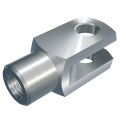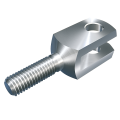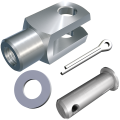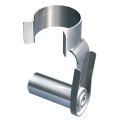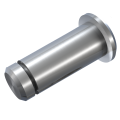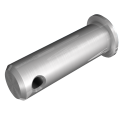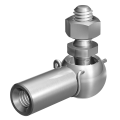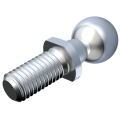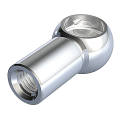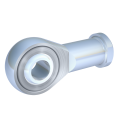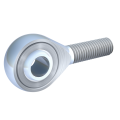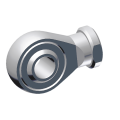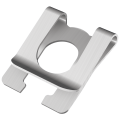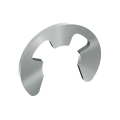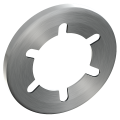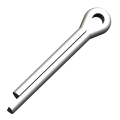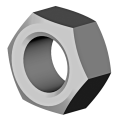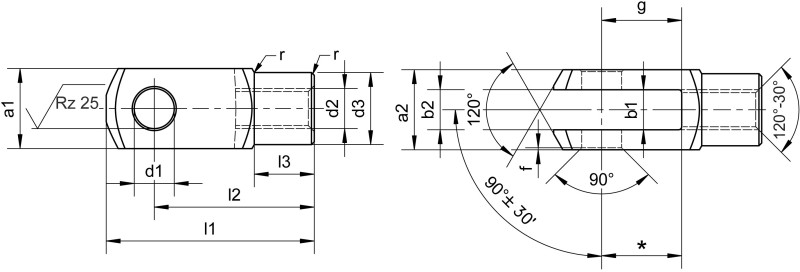Clevis
Clevises are linking elements for the transmission of static forces. They act as linking and guide elements for simple sequences of movements such as in the case of linear push/pull movements or axis offset compensation.
A clevis joint is an assembly of different components. The list below describes the individual parts corresponding to the conventional design in accordance with DIN 71751 form A:
Due to the arrangement of the parts, the friction due to movement occurs primarily between the bolt and the part connected to it and the cross-hole in the clevis.
Summary video
We have also summarised all the information below for you in a convenient video form:
Overview of the relevant designs
A series of clevis designs have become established on the market over recent years. Adherence to this standard ensures economic pricing, long-term availability of the parts and wide-ranging sourcing possibilities.
Clevis according to DIN 71752 / ISO 8140
The most widespread design is the variant defined in DIN 71752 / ISO 8140. The female thread and the slot with holes drilled on both sides ensure simple, versatile combination with other parts. The standard series contains both a short and a long variant.
Clevis with male thread
The series with male thread is basically identical to the standard design described above. The only difference is that a male thread is used. As a result, this variant is particularly suitable when the clevis has to be joined to a part with a female thread.
Clevis with elongated hole
This variant is suitable when adjustments need to be made in the area of the cross-hole. The use of a clevis with elongated-hole provides the extra space required for adjustments of this type.
Mating piece for clevises
The mating piece for a clevis performs similar tasks to the clevis itself. The main difference lies in the connection possibilities. Consequently, even thought the mating piece has a female thread just like the standard clevis, it differs considerably through the presence of a drilled stud. Thus, on the one hand, it can be used in the same way as a knuckle eye, while, on the other, it forms an ideal mating piece for the clevis and combines this to form a knee joint.
Options
All the series listed above can also be extended by the following options. These make it possible to meet special requirements or to greatly extend the service life of the joint in certain environments.
Thread
The standard variants all possess a right-hand thread. The standard assigns a corresponding thread size to each part size.
Provided that the geometry of the part permits it, parts can also be supplied with different thread sizes or a left-hand metric thread. In addition, the part can also be supplied with a corresponding fine thread with a smaller pitch for applications requiring very precise adjustment capabilities. Naturally, all these thread options can also be combined with one another.
Cross-hole
The standard provides for a cross-hole in the part. However, smaller or larger cross-holes are also possible provided that the geometry of the part permits this.
Hardened cross-hole
A hardened cross-hole increases the clevis's resistance to wear. The hardening process increases fatigue strength in the area around the cross-hole. This extends the clevis's service life, especially in aggressive and demanding applications.
Additional threads
The provision of an additional thread on the shaft permits twist-proof assembly. For the purposes of the application, the clevis is also fixed using a threaded pin according to DIN 913 / DIN EN ISO 4026 and is therefore installed in a way that prevents twisting and rotation.
Clevis with drilled hole instead of thread
Threadless variants have also become established in the automotive industry in recent years. These possess a simple drilled hole instead of the thread. The advantage of this design lies in the rapid combination with the mating piece because an automatic press fit can be established between the parts. However, this variant is only suitable for permanent connections.
Installation
Clevises usually have a fixed connection to the adjoining parts. The simplest type of join is between the corresponding mating pieces via the female thread and the cross-hole in the shaft. In this case, it is simply necessary to allow for a certain dimensional tolerance in the relevant mating piece.
In almost all such cases, the clevis is used as a clevis joint, i.e. it is combined with other parts to form a fully functional joint/pivot joint. For more information, see also Wikipedia.
For practical purposes, an extensive modular system of standard parts is available and permits a wide range of capabilities for many different applications.
AFKB
This type of joint consists simply of a clevis and a corresponding folding spring bolt. One of the great advantages of this variant is that it is very simple to assemble and disassemble. The joint also generates very little noise due to the fixed connection between the parts.
A-type joint (DIN 71751 form A)
This joint corresponds to a combination of a clevis and a bolt with pin hole together with a washer and a cotter pin. Thanks to the choice of parts, it is possible to use this solution in very compact installation spaces. In addition, this variant can also be supplied fully manufactured from stainless steel. However, it should be remembered that assembly is more demanding due to the number and properties of the individual parts.
ASL joint
Alongside the clevis, these joints also have a bolt with groove and a SL-retainer in order to fix the bolt in place.
AKL joint
This type of joint consists of a clevis, a bolt with groove and a KL-retainer in order to fix the bolt in place.
AB joint
This is a combination of a clevis, a bolt and a bayonet clip.
ABS 6799 joint
In addition to the clevis, this joint makes use of a bolt with one or optionally two grooves and a corresponding number of locking washers in accordance with DIN 6799 in order to fix the bolt in place. This variant can also be supplied fully manufactured from stainless steel.
ABS 471 joint
The components used in this variant comprise a clevis, a bolt with one or optionally two grooves and a corresponding number of retaining rings in accordance with DIN 471 in order to fix the bolt in place. This variant can also be supplied fully manufactured from stainless steel.
Knee joint
This variant takes the form of a combination of a clevis and mating piece for clevises or a rod end from dimension series E. Various variations of bolts can be used to secure it.
Joint rod
The combinations listed above can be usefully complemented and their sphere of application extended by using a threaded rod. Locknuts are generally used to assemble the modules.
Depending on sector and geographical region, this variant may also be referred to as a connecting rod, coupling rod or tie bar system. If the threaded rod is also equipped with a combination of right and left-hand threads then we talk of a turnbuckle.
Applications
Clevises are primarily used in applications involving the linear transmission of force. They are almost exclusively used as clevis joints. One great advantage lies in their simple and almost always maintenance-free use. In addition, they excel due to the modular system of parts that permits a wide range of practical applications. Force is transmitted by means of a pivot joint with precisely one degree of freedom. Clevis joints are also frequently used to compensate for play.
Typical areas of application include the automotive and railway industry, agricultural and construction machinery as well as machine and plant manufacturing.
|
Advantages |
Disadvantages |
|
Almost no maintenance and care required |
Not suitable for continuous use with dynamic loads |
|
Suitable for high linear loads |
Can only be used for simple linear applications |
|
Dismountable, releasable connection |
|
|
Standard parts: therefore available quickly, easy to replace and economical |
|

